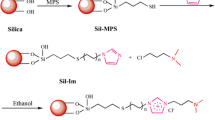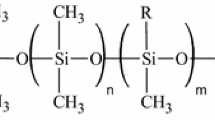Abstract
The potential of reversed-phase HPLC for the determination of distribution coefficient D 7.4 of selected 3-hydroxyquinolin-4(1H)-ones (3HQs) as compounds with significant biological activity was studied. Various stationary phases with C18 as well as hexyl-phenyl modification reflect current trends in RP-HPLC development such as higher sorbent silanophilicity, core–shell technology, hybrid and/or charged surface particles. Because of significant peak tailing of 3HQs at physiological pH on reversed-phase sorbents the separations at pH 3 were performed as well. Surprisingly, the pH change did not affect significantly the partition coefficients of 3HQs. Very affordable and common standards such as anisole, acetophenone, benzyl alcohol, brombenzene, ethylbenzoate and trichlorethylene were applied in the described methodology. The best linearity (R 2 0.9895) of the correlation between log P and log k w for standards was obtained for hexyl-phenyl sorbent, but this stationary phase was shown to be unsuitable for HPLC separation of 3HQs. The highest linearity (R 2 0.9499) of the relationship between log D 7.4 determined by the classic shake-flask method and log D determined by means of HPLC for 3HQs was attained with Cortecs C18+ column at pH 7.4. The described methodology with Cortecs C18+ as stationary phase offers fast and accurate estimation of log D 7.4 of the tested 3HQs. In an effort to increase the throughput of the HPLC method for log D 7.4 determination, we evaluated almost aqueous mobile phase that contained only 3 % of acetonitrile. Although a worse correlation between log D 7.4 determined by shake-flask method and HPLC with almost aqueous mobile phase was observed, the described procedure offers a very simple and high-throughput alternative for the estimation of log D 7.4.






Similar content being viewed by others
References
Hradil P, Hlaváč J, Soural M, Hajdúch M, Kolář M, Večeřová R (2009) 3-Hydroxy-2-phenyl-4(1H)-quinolinones as promising biologically active compounds. Mini Rev Med Chem 9:696–702
Motyka K, Hlaváč J, Soural M, Funk P (2010) Fluorescence properties of 2-aryl-3-hydroxyquinolin-4(1H)-one-carboxamides. Tetrahedron Lett 51:5060–5063
Motyka K, Hlaváč J, Soural M, Hradil P, Krejčí P, Kvapil L, Weiss M (2011) Fluorescence properties of some 2-(4-aminosubstituted-3-nitrophenyl)-3-hydroxyquinolin-4(1H)-ones. Tetrahedron Lett 52:715–717
Motyka K, Vaňková B, Hlaváč J, Soural M, Funk P (2011) Purine scaffold effect on fluorescence properties of purine-hydroxyquinolinone bisheterocycles. J Fluoresc 21:2207–2212
Kadric J, Motyka K, Džubák P, Hajdúch M, Soural M (2014) Synthesis, cytotoxic activity and fluorescence properties of a set of novel 3-hydroxyquinolin-4(1H)-ones. Tetrahedron Lett 55:3592–3595
Ortori CA, Dubern JF, Chhabra SF, Cámara M, Hardie K, Williams P, Barrett DA (2011) Simultaneous quantitative profiling of N-acyl-l-homoserine lactone and 2-alkyl-4(1H)-quinolone families of quorum-sensing signaling molecules using LC–MS/MS. Anal Bioanal Chem 399:839–850
Lépine F, Milot S, Déziel E, He J, Rahme LG (2004) Electrospray/mass spectrometric identification and analysis of 4-hydroxy-2-alkylquinolines (HAQs) produced by Pseudomonas aeruginosa. J Am Soc Mass Spectrom 15:862–869
Lipinski CA, Lombardo F, Dominy BW, Feeney PJ (1997) Experimental and computational approaches to estimate solubility and permeability in drug discovery and development settings. Adv Drug Deliv Rev 23:3–25
Testa B, Crivori P, Reist M, Carrupt PA (2000) The influence of lipophilicity on the pharmacokinetic behavior of drugs: concepts and examples. Perspect Drug Discov 17:179–211
Smith DA, Jones B, Walker DK (1996) Design of drugs involving the concepts and theories of drug metabolism and pharmacokinetics. Med Res Rev 16:243–266
Braumann T (1986) Determination of hydrophobic parameters by reversed-phase liquid-chromatography—theory, experimental-techniques, and application in studies on quantitative structure–activity-relationships. J Chromatogr 373:191–225
Giaginis C, Tsantili-Kakoulidou A (2008) Current state of the art in HPLC methodology for lipophilicity assessment of basic drugs. A review. J Liq Chromatogr Relat Technol 31:79–96
El Tayar N, Tsantili-Kakoulidou A, Roethlisberger T, Testa B, Gal J (1988) Different partitioning behavior of sulfonyl-containing compounds in reversed-phase high-performance liquid chromatography and octanol-water systems. J Chromatogr 439:237–244
Kaliszan R (1990) High-performance liquid-chromatographic methods and procedures of hydrophobicity determination. Quant Struct Act Relat 9:83–87
Minick DJ, Frenz JH, Patrick MA, Brent DA (1988) A comprehensive method for determining hydrophobicity constants by reversed-phase high-performance liquid-chromatography. J Med Chem 31:1923–1933
Bechalany A, Tsantili-Kakoulidou A, El Tayar N, Testa B (1991) Measurement of lipophilicity indexes by reversed-phase high-performance liquid-chromatography—comparison of 2 stationary phases and various eluents. J Chromatogr 541:221–229
Neue UD, Tran K, Iraneta PC, Alden PA (2003) Characterization of HPLC packings. J Sep Sci 26:174–186
Vervoor RJ, Debets AJ, Claessens HA, Hramers CA, de Jong GJ (2000) Optimisation and characterisation of silica-based reversed-phase liquid chromatographic systems for the analysis of basic pharmaceuticals. J Chromatogr A 897:1–22
Lombardo F, Shalaeva MY, Tupper KA, Gao F (2001) ElogD(oct): a tool for lipophilicity determination in drug discovery. 2. Basic and neutral compounds. J Med Chem 44:2490–2497
Liu X, Tanaka H, Yamauchi A, Testa B, Chuman H (2005) Determination of lipophilicity by reversed-phase high-performance liquid chromatography—influence of 1-octanol in the mobile phase. J Chromatogr A 1091:51–59
Donavan SF, Pescatore MC (2002) Method for measuring the logarithm of the octanol-water partition coefficient by using short octadecyl-poly(vinyl alcohol) high-performance liquid chromatography columns. J Chromatogr A 952:47–61
Liu X, Tanaka H, Yamauchi A, Testa B, Chuman H (2004) Lipophilicity measurement by reversed-phase high-performance liquid chromatography (RP-HPLC): a comparison of two stationary phases based on retention mechanisms. Helv Chim Act 87:2866–2876
Bard B, Carrupt P-A, Martel S (2012) Determination of alkane/water partition coefficients of polar compounds using hydrophilic interaction chromatography. J Chromatogr A 1260:164–168
Pidgeon C, Ong S, Liu H, Qui X, Pidgeon M, Dantzig AH, Munroe J, Hornback WJ, Kasher JS, Glunz L, Szczerba T (1995) IAM chromatography—an in vitro screen for predicting drug membrane-permeability. J Med Chem 38:590–594
Bocian S, Buszewski B (2015) Comparison of retention properties of stationary phases imitated cell membrane in RP HPLC. J Chromatogr B 990:198–202
Hradil P, Krejčí P, Hlaváč J, Wiedermannová I, Lyčka A, Bertolasi V (2004) Synthesis, NMR spectra and X-ray data of chloro and dichloro derivatives of 3-hydroxy-2-phenylquinolin-4(1H)-ones and their cytostatic activity. J Heterocyclic Chem 41:375–379
Hradil P, Jirman J (1995) Collect Czech Chem Commun 60:1357–1366
Hradil P, Hlaváč J, Lemr K (1999) Preparation of 1,2-disubstituted-3-hydroxy-4(1H)-quinolinones and the influence of substitution on the course of cyclization. J Heterocyclic Chem 36:141–144
Giaginis C, Theocharis S, Tsantili-Kakoulidou A (2006) Contribution to the standardization of the chromatographic conditions for the lipophilicity assessment of neutral and basic drugs. Anal Chim Acta 573–574:311–318
Schoenmakers PJ, Billiet HAH, de Galan L (1979) Influence of organic modifiers on the retention behaviour in reversed-phase liquid chromatography and its consequences for gradient elution. J Chromatogr 185:179–195
Horvath C, Melander Molnar I (1976) Solvophobic interactions in liquid chromatography with nonpolar stationary phases. J Chromatogr 125(1976):129–156
Mackay D, Shiu W-Y, Ma K-C, Lee SC (2006) Handbook of physical–chemical properties and environmental fate for organic chemicals, 2nd edn. CRC Press, Boca Raton
Martinez CHR, Dardonville C (2013) Rapid determination of ionization constants (pK(a)) by UV spectroscopy using 96-well microtiter plates. ACS Med Chem Lett 4:142–145
Acknowledgments
The infrastructural part of this project (Institute of Molecular and Translational Medicine) was supported by the National program of sustainability (LO1304).
Author information
Authors and Affiliations
Corresponding author
Ethics declarations
Conflict of interest
Author Tereza Volná declares that she has no conflict of interest. Author Kamil Motyka declares that he has no conflict of interest. Author Jan Hlaváč declares that he has no conflict of interest.
Ethical approval
This article does not contain any studies with human participants or animals performed by any of the authors.
Rights and permissions
About this article
Cite this article
Volná, T., Motyka, K. & Hlaváč, J. Potential of High-Performance Liquid Chromatography for Distribution Coefficient Determination of 3-Hydroxyquinolin-4(1H)-one Derivatives. Chromatographia 79, 1153–1163 (2016). https://doi.org/10.1007/s10337-016-3129-6
Received:
Revised:
Accepted:
Published:
Issue Date:
DOI: https://doi.org/10.1007/s10337-016-3129-6




